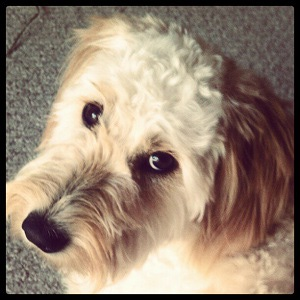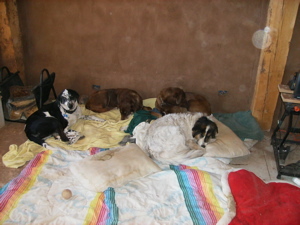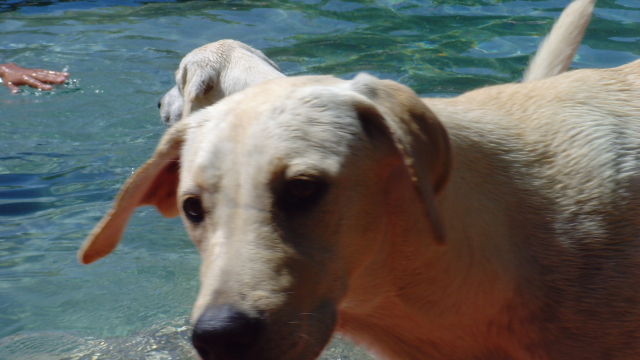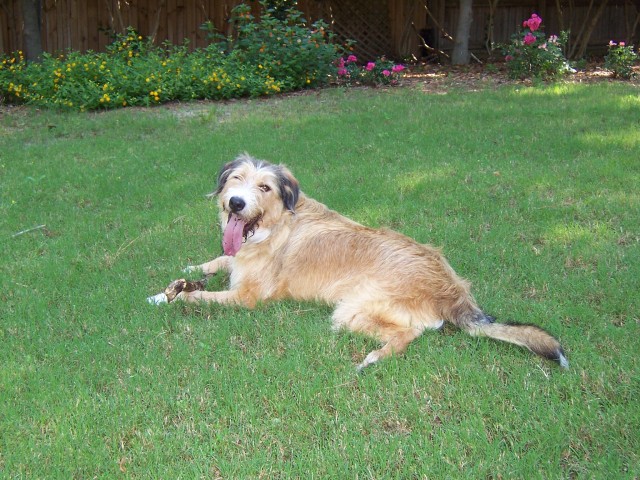QuestionDear Alan,
I have a terrier who we think has some scotch terrier in him. He's a smart little chap and seems to pick up things very quickly and is quite OK around me. The trouble is the minute he comes in contact with any other dogs just spots them basically he becomes very savage and wnts to attack them no matter what their size. At the moment I am taking him to obedience training and it is a real misery for me as he becomes very nasty and if i get in the way well I get bitten. He doesn't draw blood but it still hurts and I am worried he will slip his collar and attack. Apart from that he is sweet-natured and a great little watch dog. He has been desexed so I am at a loss what to do. To me it is almost like he is scared. We came to get Oscar when he was just coming out of the puppy stage as he had been a stray. I have 7 year old twins so i am really wondering if I can trust him at all around them. I am too scared to take him on walks as if he meets another dog it is very horrible for me
Thanks Melinda
AnswerDear Melinda,
Thank you for your question-sorry to hear of your troubles. There have been volumes of books and studies published about canine aggressive behaviors. It is a complex issue that cannot be fully addressed via this message board. Without attempting to write a book here, I'll give you a brief overview of the behavior, some tips for managing the behavior and resources for additional step-by-step instructions.
You're right! Oscar's behavior near other dogs probably began as a fearful response, now it has become somewhat "automatic".
Never scold Oscar when he gets too excited around other dogs. This will probably make the situation worse. He's already uncomfortable around other dogs and your attacks will only verify his belief that the sight of other dogs is a reason to be afraid.
Most dogs that exhibit fearful or aggressive responses perceive threats when there are none. In order to help a dog with this problem, the dog's inaccurate perception of danger associated with actions of other dogs, strangers, children, et cetera must be modified so that the dog no longer perceives the approach, actions or presence of theses triggers as threats.
This is accomplished by a very effective process of systematic desensitization and counter-conditioning or behavior modification. If the triggers for aggression or fearful behaviors cannot be determined, the prospects for recovery are poor. If the triggers can be identified (and the program is executed properly), the prognosis is good.
The exercises performed during behavior modification are based on the scientific principles of operant and classical conditioning. The dog is carefully exposed to low levels of the triggers (stimuli) for the unwanted responses during many short cycles and the dog's non-reactive behaviors are reinforced (rewarded). As the exercise progresses, each cycle is adjusted so that the dog is exposed to a slightly higher level of the stimuli than the previous cycle. The end result is a dog that is no longer aggressive or fearful in the presence of the stimuli, but is calm and relaxed in the presence of the stimuli.
The first priority is to minimize Oscar's exposures to situations that trigger the behavior. Every time he acts out, it strengthens his desire to repeat the behavior. Group class is a poor environment for Oscar. He is in a situation in which he is not comfortable and is not prepared to navigate. Talk to the instructor about private lessons instead.
Walk Oscar very early or late in the day.
Obtain a Gentle Leader head collar or at the very least, a martingale collar. Either collar (when fitted correctly) will not slip off. The Gentle Leader will give you complete control and would be my choice. If you get the Gentle Leader, purchase the instructional DVD as well. The Gentle Leader requires a bit more practice than other training collars.
Next, establish a teacher-student environment so that Oscar is motivated to determine what you want and is motivated to want the same thing. You only have three things that Oscar wants from you and he is probably getting these things regardless of his behavior. He wants food, attention and touch or F.A.T.. Right now he has no idea that you are providing these needs, because he gets them without any behavioral requirements. Until he realizes that the good stuff you give is an immediate consequence of his behavior, he will not attempt to change. You can do a web search on "NILIF" for more information about this step. Here is the abridged version:
From now on, ask him to sit before you provide anything he wants. When he approaches you for attention, ask him to sit; when he wants to go out the door, ask him to sit; when he wants you to throw the ball, ask him to sit; before you attach his leash, ask him to sit; is he wants to sniff a bush off the path (during a walk), ask him to sit; et cetera. If he doesn't sit, he doesn't get what he wants, just walk away. Soon he will learn that the good stuff happens when he listens to you. Obviously this step can not be performed when he is in "attack" mode, but is performed when there are no distractions.
Feeding should be placed on a schedule. In other words, don't leave a bowl of food out all the time. Place the food down, allow him 9 or so minutes to eat and then remove the bowl. This will make him realize that you control the food, thus you are important!
Next, you should teach Oscar a simple skill that can be used to help him focus on a task that is incompatible with aggressive or fearful behaviors. I like to teach a two-finger target for this step. You teach the dog to bump your extended two fingers for a treat. This provides a visual point of focus that is away from the other dogs and towards you.
Next, teach Oscar to sit and to attend to you in non-stimulating environments.
Practice sit and attention in quiet locations and then in mildly stimulating environments. Once Oscar will sit and attend to you in the presence of mild distractions, practice sit and attention (or use the two-finger target) when Oscar is slightly excited during play.
Ask him to sit and attend to you or to target your two-finger target. Once he is settled, praise him and give him a treat, and then immediately elevate his level of excitement by resuming play. Then, once again, ask him to sit and attend to you. Practice this routine inside and outside, in various mildly distracting environments and locations.
The goal is to give Oscar lots of practice transitioning from an excited to a relaxed and attentive state (when other dogs are not around).
Once you have established a teacher-student environment, taught the dog a simple behavior that is incompatible with the unwanted behavior and taught the dog to pay attention to you when he is excited, the actual treatment for behaviors can begin.
You'll need a helper with another dog. Start from a distance where the other dog is in sight but not close enough to trigger Oscan's aggression. When he sees the other dog, tell him, "there's spot" and then ask him to sit or to target your two-finger target. Pay him for compliance with praise and/or treats. Then, move away from Spot to give him a short break. After the short break, take a couple of steps towards Spot (each cycle should be closer then the one before) and repeat the sequence.
Each time you hold these sessions, he should be exposed to the other dog at levels in which he can succeed. If he will not attend to you, you are too close. Move away from the other dog. Each of these sessions should be at least 90 minutes in length.
If another dog approaches when you are on a walk, move off the path and ask Oscar to sit or to target your two-finger target.
There are other things to consider. Make sure Oscar gets plenty of exercise and feed a balanced, quality diet. It can helpful to begin a massage program to help Oscar learn how to relax. Teaching relaxation is difficult to explain here, but you can learn how to massage via the book, Canine Massage, A Complete Reference Guide by Jean-Pierre Hourdebaigt Another book, The Cautions Canine by Patricia B. McConnell has step by step instructions. Happy Training!
AT

 Agressive 1 yr old mini goldendoodle
Question
our millie
My husband and I got our min
Agressive 1 yr old mini goldendoodle
Question
our millie
My husband and I got our min
 uncontrollable beagle
Question
max
My beagle is a year and a half. Ive had hi
uncontrollable beagle
Question
max
My beagle is a year and a half. Ive had hi
 Sudden aggression within pack after a death
Question
Sudden aggression in o
We have an approximatel
Sudden aggression within pack after a death
Question
Sudden aggression in o
We have an approximatel
 Psychological trauma
Question
Izzy
I recently took my 1 year old dog to a fr
Psychological trauma
Question
Izzy
I recently took my 1 year old dog to a fr
 anxious dog
Question
Louie
Hi, We adopted a 2 year old male A
anxious dog
Question
Louie
Hi, We adopted a 2 year old male A